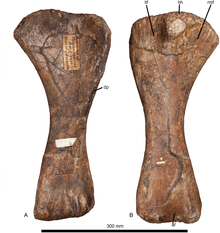Haestasaurus
| Haestasaurus | |
|---|---|

| |
| Left humerus of the type specimen | |
| Scientific classification | |
| Domain: | Eukaryota |
| Kingdom: | Animalia |
| Phylum: | Chordata |
| Clade: | Dinosauria |
| Clade: | Saurischia |
| Clade: | †Sauropodomorpha |
| Clade: | †Sauropoda |
| Clade: | †Neosauropoda |
| Clade: | †Macronaria |
| Genus: | †Haestasaurus Upchurch, Mannion, & Taylor, 2015 |
| Species: | †H. becklesii
|
| Binomial name | |
| †Haestasaurus becklesii (Mantell, 1852)
| |
Haestasaurus is a
Description


As a sauropod, Haestasaurus would have been a large quadrupedal long-necked dinosaur. Little information is available about the specifics of its build because only a forelimb is known of the animal.
An indication of the size of Haestasaurus is given by the length of the forelimb elements. The humerus is 599 millimetres long, the ulna 421 millimetres and the radius, situated next to the ulna in the lower arm, has a length of 404 millimetres.[1]
A 2015 study found several unique anatomical traits (
A rock associated with the forelimb, NHMUK R1868, was the first specimen known preserving parts of the sauropod skin. These probably are not impressions as the visible surface of the scales is convex, but natural casts. An area of 215 by 195 millimetres has been preserved. It shows non-overlapping hexagonal scales with a diameter of between ten and twenty-five millimetres. The scales gradually decrease in size, perhaps towards the elbow, to provide it greater flexibility. The scales strongly resemble skin impressions of later sauropod finds..
History of discovery and naming
In 1852, the collector

Pelorosaurus becklesii at first received little attention, perhaps also because the fossils remained in the private collection of Beckles; they were acquired by the
In 2015, Paul Upchurch, Philip D. Mannion and

The
Relationships
By the end of the twentieth century, most researchers agreed that P. becklesii was a member of the
References
- ^
- PMID 35145214.
- ^ Hooley, R.W. 1917. "On the integument of Iguanodon bernissartensis Boulenger, and of Morosaurus becklesii Mantell". Geological Magazine 6: 148–150
- ^ Mantell G.A., 1852, "On the structure of the Iguanodon and on the fauna and flora of the Wealden Formation", Notice: Proceedings of the Royal Institute of Great Britain. 1852 1: 141–146
- ^ Lydekker R., 1888, "Note on a new Wealden Iguanodont and other Dinosaurs", Quarterly Journal of the Geological Society 44: 46–61
- ^ Marsh O.C., 1889, "Comparison of the principal forms of the Dinosauria of Europe and America", American Journal of Science (series 3), 37: 323–330
- ^ Nicholson H.A. & Lydekker R., 1889, Manual of Palaeontology Volume 2. Edinburgh and London: Blackwood
- ^ Lydekker R., 1890, "On remains of small sauropodous dinosaurs from the Wealden", Quarterly Journal of the Geological Society of London, 46: 182–184
- ^ Lydekker R., 1893, "On a sauropodous dinosaurian vertebra from the Wealden of Hastings", Quarterly Journal of the Geological Society 49: 276–280
- ^ Von Huene, F., 1932, Die fossile Reptil-Ordnung Saurischia, ihre Entwicklung und Geschichte, Monographien zur Geologie und Palaeontologie 1(4), Leipzig: Gebrueder Borntraeger pp. 361
- ^ McIntosh J.S., 1990, "Sauropoda". In: Weishampel D.B., Dodson P., Osmólska H., (editors), The Dinosauria. First Edition, Berkeley: University California Press, pp. 345–401
- ^ "The Open Access Dinosaurs of 2015". PLOS Paleo.
